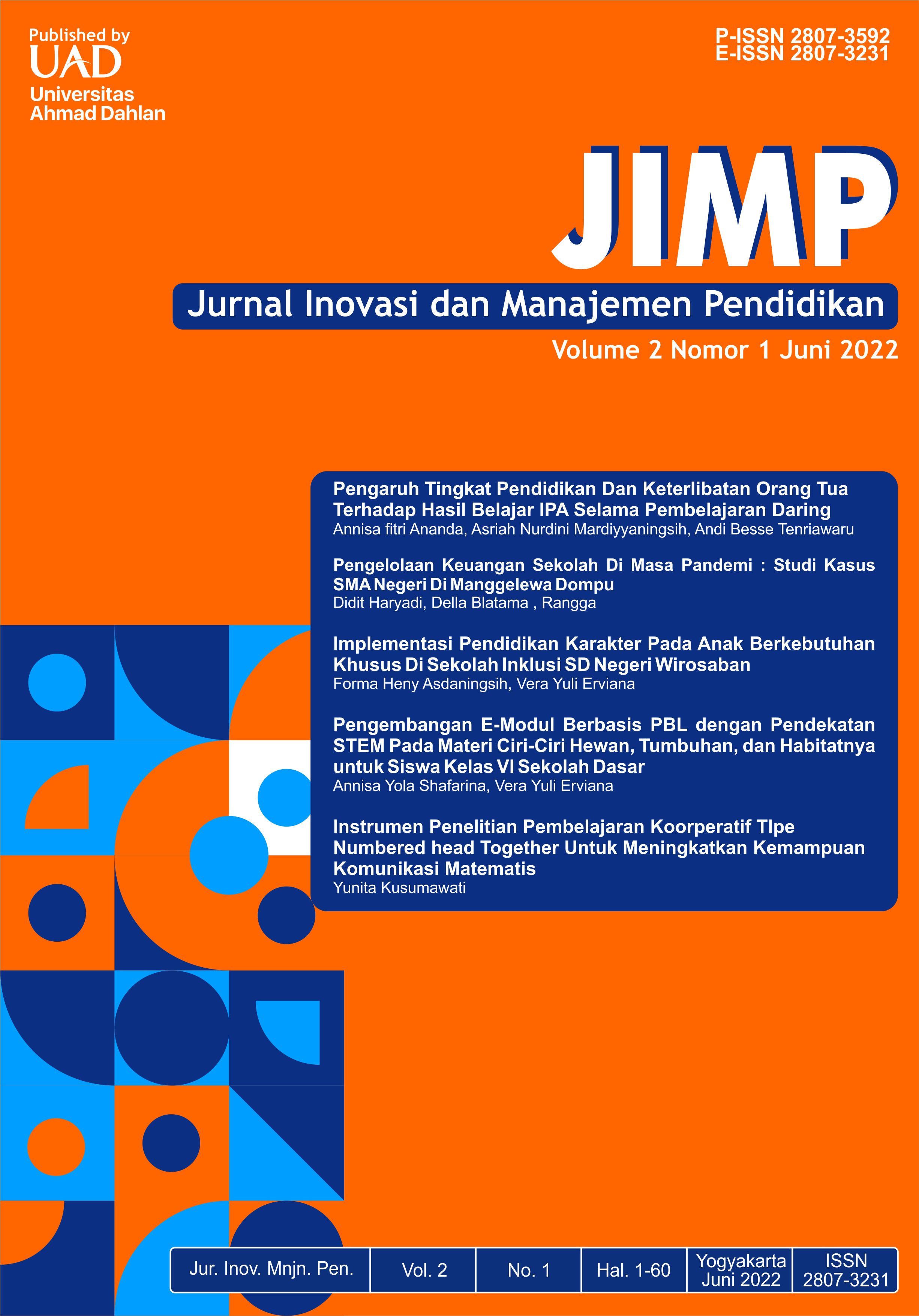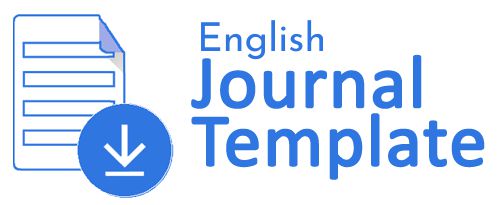Pengembangan E-Modul Berbasis PBL dengan Pendekatan STEM Pada Materi Ciri-Ciri Hewan, Tumbuhan, dan Habitatnya untuk Siswa Kelas VI Sekolah Dasar
DOI:
https://doi.org/10.12928/jimp.v2i1.4843Keywords:
E-Module, Problem Based Learning, STEM ApproachAbstract
This research is motivated by the use of learning media which is still limited, and only school textbooks that do not prioritize the development of students' problem solving abilities are used. This study aims to understand the steps of developing the modular characteristics of animals, plants and their habitats and to determine their quality. This development research uses the ADDIE model (analysis, design, development, implementation, and evaluation). The objects of this research are material expert teachers, media experts, linguists, learning experts and sixth grade teachers at SD Negeri Kalongan. Data collection techniques in the form of assessment. Quantitative and qualitative data analysis was used to evaluate teaching materials. This research develops modules on the characteristics of animals, plants and their habitats. The results showed that the quality of material experts was in the appropriate category, with an average score of 3.2. The quality assessment carried out by a linguist in the appropriate category had a mean score of 3.0. The quality assessment carried out by media experts using the very appropriate category has an average score of 3.4. The quality assessment carried out by learning experts has a very user-friendly category with an average score of 3.3. The teacher assesses the quality in the very appropriate category, with an average score of 3.8. These results indicate that the quality of the module is included in the very feasible category to be used as teaching materials.References
Alfika, Z. A., Mayasari, T., & Kurniadi, E. (2019). Modul STEM Berbasis Pemecahan Masalah dengan Tema Rumah dome. Jurnal Pendidikan Fisika, 93-105.
Anggraini, R., Wahyuni, S., & Lesmono, A. D. (2016). Pengembangan lembar kerja siswa (Lks) berbasis keterampilan proses di SMAN 4 Jember. Jurnal Pembelajaran Fisika, 350-356.
Devi, P. K. (2015). Materi Pelatihan Guru Implementasi Kurikulum 2013. Jakarta: Badan Pengembangan SDM Pendidikan dan Kebudayaan.
Fitriyani, Z. (2020). Pengembangan E-Modul berbasis STEM (Science, Technology, Engineering, And Mathematics) berbantuan android pada materi segiempat . Doctroral Dissertation.
Gunantara, Suarjana, & Riastini Nanci. (2014). an Kreatifitas Siswa melalui STEM dalam Pembelajaran IPA Increasing Student Creativity through STEM in Science Learning. Jurnal Mimbar PGSD Universitas Pendidikan Ganesha, 1-10.
Herak, R., & Lamanepa, G. H. (2019). Meningkatkan Kreatifitas Siswa melalui STEM dalam Pembelajaran IPA Increasing Student Creativity through STEM in Science Learning. Jurnal EduMathSains, 89-98.
Hidayat, R., M, V. D., & Ulya, H. (2019). Kompetensi kepala sekolah abad 21: Sebuah tinjauan teoretis. Jurnal Kepemimpinan dan Pengurusan Sekolah, 61-68.
Kimianti, F., & Prasetyo, Z. K. (2019). Pengembangan e-modul IPA berbasis problem based learning untuk meningkatkan literasi sains siswa. Jurnal Teknologi Pendidikan, 91-103.
Mayasari, T., Kadarohman, A., Rusdiana, D., & Kaniawati, I. (2016). Apakah model pembelajaran problem based learning dan project based learning mampu melatihkan keterampilan abad 21. Jurnal Pendikan Fisika dan Keilmuwan, 48-55.
Mulyaningsih, E. (2014). Metode Penelitian Terapan Bidang Pendidikan. Bandung: Alfabeta.
Pazlina, N., & Usmeldi, U. (2020). Pengembangan E-Modul Dasar-dasar Listrik dan Elektronika Berbasis Problem-Based Learning. Jurnal Pendikan Teknik Elekro, 71-74.
Saputri, D. A., Harizon, & Malik, A. (2021). Pengembangan e-Modul berbasis PBL Berbantuan Instagram pada Materi Koloid Kelas XI MIPA. pp. 1-7.
Sukmana, R. W. (2018). Pendekatan science, technology, engineering and mathematics (stem) sebagai alternatif dalam mengembangkan minat belajar peserta didik sekolah dasar. Jurnal Ilmiah Pendidikan Dasar, 189-197.
Zulaiha, F., & D, K. (2020). Pengembangan Modul Berbasis STEM untuk Siswa SMP. Jurnal Pendidikan Fisika dan Teknologi, 246-255.
Downloads
Published
How to Cite
Issue
Section
License
Copyright (c) 2022 Annisa Yola Shafarina, Vera Yuli Erviana

This work is licensed under a Creative Commons Attribution-ShareAlike 4.0 International License.
This article's copyright is transferred to Universitas Ahmad Dahlan (UAD) if and when the item is accepted for publication. The undersigned hereby transfers any rights in and to the paper including without limitation all copyrights to UAD. The undersigned hereby represents and warrants that the article is original and that he/she is the author of the paper, except for material identified as to its source, with permission notices from the copyright owners where required. The undersigned represents that he/she has the power and authority to make and execute this assignment.
We declare that:
This paper has not been published in the same form elsewhere.
It will not be submitted anywhere else for publication before acceptance/rejection by this Journal.
Copyright permission is obtained for materials published elsewhere and which require this permission for reproduction.
Furthermore, I/We hereby transfer the unlimited rights of publication of the above-mentioned paper in whole to UAD. The copyright transfer covers the exclusive right to reproduce and distribute the article, including reprints, translations, photographic reproductions, microform, electronic form (offline, online), or any other reproductions of similar nature.
The corresponding author signs for and accepts responsibility for releasing this material on behalf of any co-authors. This agreement is to be signed by at least one of the authors who have obtained the co-author(s) assent where applicable. After submission of this agreement signed by the corresponding author, changes of authorship or in the order of the authors listed will not be accepted.
Retained Rights/Terms and Conditions
Authors retain all proprietary rights in any process, procedure, or article of manufacture described in the Work.
Authors may reproduce or authorize others to reproduce the Work or derivative works for the author's personal use or company use, provided that the source and the UAD copyright notice are indicated, the copies are not used in any way that implies UAD endorsement of a product or service of any employer, and the documents themselves are not offered for sale.
Although authors are permitted to re-use all or portions of the Work in other works, this does not include granting third-party requests for reprinting, republishing, or different types of re-use.







